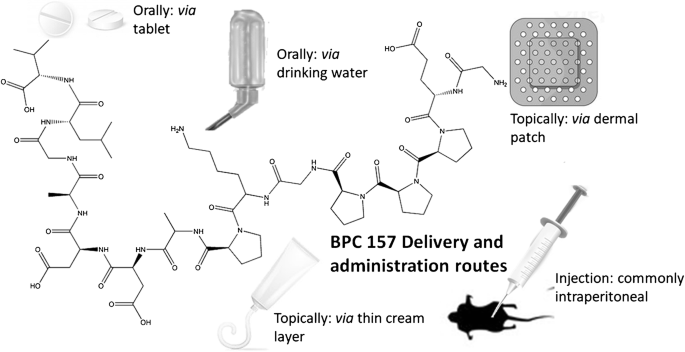
Certain peptides have garnered significant attention due to their potential benefits in the realms of wound healing, tissue repair, and regeneration. Among the notable peptides with remarkable healing properties are BPC-157, TB500, Melanotan 2, LL-37 and Sermorelin.
Peptides, consisting of concise chains of amino acids, usually comprising less than 50 amino acid residues, have emerged as remarkable therapeutic agents. Their compact size and unique amino acid sequences enable peptides to interact with specific receptors within the body, influencing various physiological processes. These versatile molecules function as vital components in the body’s natural signaling pathways and regulatory systems, serving as signaling molecules, neurotransmitters, hormones, or enzyme inhibitors, among other roles. The ability of peptides to engage with precise receptors or molecules allows for targeted and precise effects.
In recent years, peptides have gained prominence for their potential applications in addressing various medical conditions. Peptides tailored for recovery, tendon repair, injury management, and muscle recovery have all been explored in animal studies. They offer advantages such as exceptional specificity, low toxicity, and the capacity to mimic natural biological processes. Furthermore, peptides can be synthesized and engineered to enhance their stability, bioavailability, and target specificity, rendering them exceptionally convenient for therapeutic purposes.
The therapeutic applications of peptides encompass:
- Hormone Regulation: Peptides can serve as hormone analogs or modulators, influencing hormone production, release, or activity. Notable examples include insulin and glucagon-like peptide-1 (GLP-1), which play pivotal roles in blood sugar regulation.
- Immune Response Modulation: Certain peptides interact with immune cells, modulating immune responses like inflammation or immune cell activation, holding potential in autoimmune disease and cancer treatment.
- Antimicrobial Activity: Some peptides exhibit antimicrobial properties, effectively inhibiting the growth of bacteria, viruses, fungi, and other pathogens, thus emerging as potential alternatives to conventional antibiotics.
- Pain Management: Specific peptides target pain receptors or neurotransmitters involved in pain signaling, offering potential applications in pain management and analgesic development.
- Tissue Repair and Regeneration: Peptides that stimulate cell proliferation, migration, or tissue remodeling are being studied for their promise in wound healing, tissue regeneration, and tissue engineering.
Exploring the Best Healing Peptides
Several peptides have distinguished themselves for their extraordinary potential in wound healing, tissue repair, and regeneration. These exceptional healing peptides include BPC-157, TB500, Melanotan 2, and Sermorelin.
BPC-157(Body Protective Compound-157)
Derived from a protein found in gastric juice, BPC-157 is a synthetic peptide exhibiting remarkable effects in promoting tissue repair across various animal models, spanning muscle, tendon, and gastrointestinal tissues. BPC-157 appears to work through multiple mechanisms, including the stimulation of blood vessel formation, reduction of inflammation, and enhancement of cell migration and proliferation. Notably, BPC-157 demonstrates a significant ability to accelerate tendon growth by fostering fibroblast outgrowth, survival, and migration in mouse models, addressing the typically slow and challenging healing process associated with tendons. Additionally, BPC-157 improves the quality of tendon healing, as observed in rat models, leading to preserved muscle motor function, walking patterns, and reduced joint contracture. The mechanism underlying BPC-157’s promotion of tendon repair likely involves enhancing fibroblast function by upregulating growth hormone receptors without off-target effects associated with growth hormone supplementation. While the majority of BPC-157 research has been conducted in animal models, it is noteworthy that BPC-157 is a naturally occurring peptide in human gastric contents, showing promise in human clinical trials for inflammatory bowel disease therapy and underscoring its potential for tendon repair.
TB500 (Thymosin Beta-4)
Thymosin Beta-4, a naturally occurring peptide involved in various cellular processes, including wound healing and tissue repair, has a synthetic analogue known as TB500. Both peptides share similar properties, promoting angiogenesis (formation of new blood vessels), cell migration to injury sites, and inflammation modulation. Thymosin Beta-4, and by extension TB500, have been explored extensively in preclinical and clinical settings for their therapeutic potential in wound healing, corneal repair, and cardiac regeneration. These peptides excel in:
– Angiogenesis: They stimulate the formation of new blood vessels, facilitating oxygen and nutrient delivery to injury sites, critical for effective tissue repair.
– Cell Migration: Enhanced cell migration, particularly of endothelial cells and fibroblasts, supports granulation tissue formation, vital for wound healing.
– Anti-inflammatory Effects: They modulate the inflammatory response by reducing pro-inflammatory cytokines and promoting anti-inflammatory molecule production, creating an ideal environment for healing and tissue repair.
– Wound Healing: Studies demonstrate accelerated wound healing in various models, including skin wounds, corneal injuries, and muscle injuries, enhancing tissue regeneration and improving healed tissue’s structural and functional properties.
– Corneal Repair: Thymosin Beta-4 shows promise in promoting corneal repair and regeneration, addressing conditions like corneal injuries, ulcers, and dystrophies.
– Cardiac Regeneration: Research suggests potential benefits in promoting cardiac tissue repair and improving heart function post-heart attack in animal models and small clinical trials.
Melanotan 2
Although not conventionally associated with healing peptides, Melanotan 2 merits attention for its potential wound healing properties. It demonstrates the ability to expedite wound closure and reduce inflammation in animal models. Additionally, Melanotan 2 exhibits melanotropic effects, stimulating skin pigmentation and exploring applications in conditions such as vitiligo. Research in mouse models suggests that Melanotan 2 can reduce amyloid accumulation, a hallmark feature of Alzheimer’s Disease, and diminish the presence of A1 subtype reactive astrocytes, which play a role in neurotoxicity and neuronal death. These findings propose Melanocortin activation as a promising therapeutic target for Alzheimer’s Disease and potentially other degenerative brain diseases, opening new avenues for treatment.
LL-37
Naturally produced by immune cells, including neutrophils and macrophages, LL-37 stands out as an antimicrobial peptide known for its broad-spectrum activity against bacteria, fungi, and viruses. Its multifaceted actions make LL-37 an exceptional peptide for recovery, particularly in injuries contaminated by pathogens. LL-37’s mechanisms include direct disruption of microbial cell membranes, modulation of immune responses, and promotion of skin cell migration and proliferation. Furthermore, LL-37 stimulates the production of growth factors and extracellular matrix components, pivotal for tissue repair and regeneration. Consequently, LL-37 is a promising therapeutic agent for treating infected wounds and chronic ulcers, supported by research studies and preclinical trials demonstrating its efficacy in enhancing wound healing and reducing microbial burden across various wound types.
Sermorelin
Sermorelin’s beneficial effects encompass tissue regeneration, scar reduction, inflammation mitigation, and lowered infection risk following injuries. Administered post-injury, sermorelin has demonstrated the potential to enhance tissue health, stimulate wound repair, and decrease inflammation through cytokine modulation. As a growth hormone (GH) release stimulant, sermorelin aligns with peptides for muscle repair, tendon repair, and injury management. Its ability to raise GH levels correlates with increased extracellular matrix deposition, providing the structural framework for wound repair, including collagen and elastin production. This balance is pivotal for optimal wound healing without excessive scar formation. Sermorelin has also exhibited potential in heart attack recovery, protecting heart cells, promoting new blood vessel growth, and reducing inflammatory cytokines, ultimately reducing scar extent and density, improving long-term outcomes post-heart attack.
A Glimpse into the Future
Peptides have emerged as potent tools for therapeutic healing, each offering unique mechanisms and benefits. While current research often focuses on individual peptides, the potential synergies resulting from combining two or more of these peptides warrant exploration. Future research should consider these synergistic possibilities, offering exciting prospects for further enhancing the healing process.






